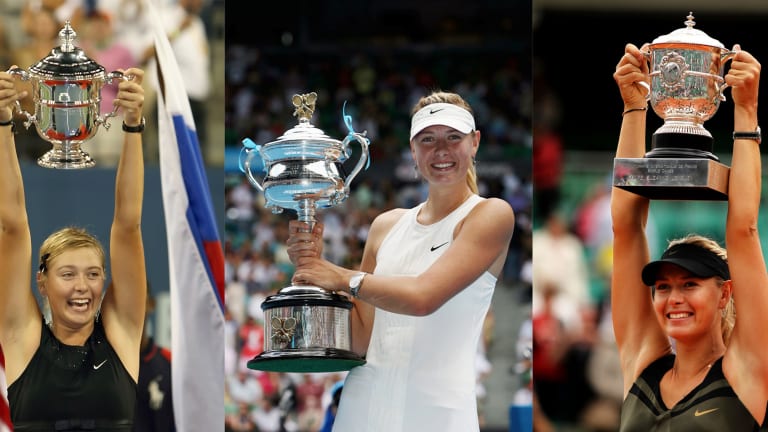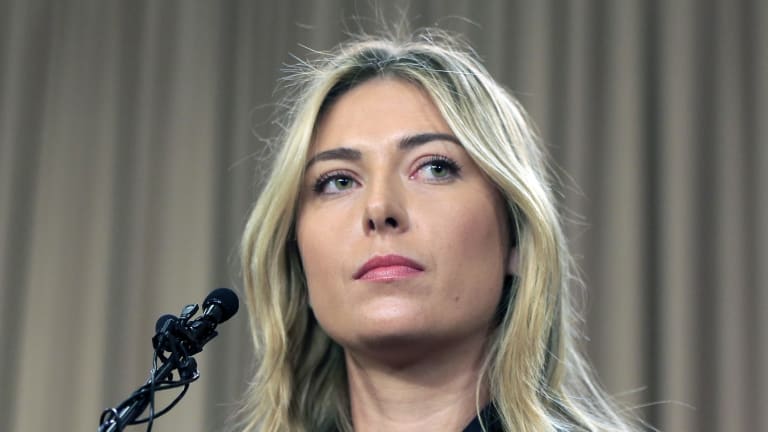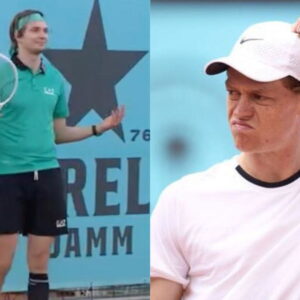For most tennis fans, the only memorable aspect of the 2002 Wimbledon men’s final was the sight of a streaker bounding his way across Centre Court, and bringing a moment of hysteria to the normally orderly arena. If only the match, between Lleyton Hewitt and David Nalbandian, had been half as entertaining.
Fortunately, there was another, more intriguing final played at the All England Club that Sunday, one that would give us a glimpse into the sport’s near future. When Hewitt-Nalbandian came to its mercifully swift conclusion, I wasted no time making my way to the thinly populated side court where a sure-shot teenager named Maria Sharapova was playing for the girls’ title.
She was only 15, but her name had been in circulation for a few years. When a prodigy arrived with recommendations from Nick Bollettieri and Robert Lansdorp, you made sure you took a look. A look, and a listen. I could hear Sharapova, and her soon-to-be famous grunt, before I got to the court. In those says, she also hummed as she hit some shots. She did that at maximum volume, too.

Sharapova made her presence heard at Wimbledon from an early age.
© Getty Images
Her frenetic, full-throated desire to win was what struck me most that day. There were smoother movers and more powerfully built athletes in the juniors, but this skinny-armed blonde looked as if she could overwhelm them all by sheer, feverish force of will. Along with Venus and Serena Williams and Rafael Nadal, Sharapova brought a new, headlong intensity to a new century of tennis.
Anything new in this tradition-bound sport tends to be polarizing, and that was true of Sharapova’s icy ruthlessness. Her shriek, her shivery strut and her bash-first style were a bit of a shock to fans’ senses. But as a tactic, her demeanor was effective. From the moment she walked into a stadium—upright, poker-faced, with purposeful little steps—she set a no-nonsense tone, and her opponents were left with no choice but to react to it. Or copy it. Her habit of walking to the back fence before she served, gathering herself, and then spinning back toward the baseline with her left fist clenched, would become a standard ritual among the next WTA generation.
I was impressed with Sharapova in 2002, but never dreamed that, two years later, she would beat Serena for the Wimbledon title. That week Sports Illustrated featured a photo of the beaming, 17-year-old champion on its cover, alongside the words “Star Power.” Sharapova would indeed become big business: Every year from 2008 to 2016, she topped the Forbes list of the world’s highest-paid women athletes.
More important, Sharapova lived up to her star billing on the court. Even amid her endorsements and cover shoots, she remained a competitor first. Her early passion for the fight never faded, and her point-by-point persistence never flagged; her record in marathon matches is a testament to that. She didn’t have an elegant game, double faults were an issue, and when she was bad, she could be very bad. But her ground-stroke drives were thrilling when she connected, and the backhand drop shot she developed was proof that there was more subtlety to her style than has been advertised.
A fast-court lover to start, she was ambitious enough to transform herself into a clay-court specialist, and win Roland Garros twice. Sharapova spent 21 weeks at No. 1, won 36 titles, and was the seventh woman in the Open era to complete a career Grand Slam.

Sharapova won the US Open in 2006, the Australian Open in 2008, and Roland Garros twice, in 2012 and 2014.
© Getty Images
Maybe most admirable to me, though, was the way Sharapova lost. After a defeat, she gave her opponent a respectful handshake and head nod; drive-bys and hugs weren’t her style. The woman she lost the most to, of course, was Serena; Sharapova ended up with a galling 2-20 record against her nemesis. Yet she never showed any embarrassment or despair about what became a world-famous spectacle of futility. She kept trying, kept losing—and kept coming back again.
In 2011 in Indian Wells, Sharapova played horribly in a semifinal loss to Caroline Wozniacki. She was gloomy at the start of her press conference, but talking helped, and her answers grew deeper and funnier. Soon she was reminiscing about her childhood and joking that she “didn’t have the guts” to smash her racquet. On court that evening, her best days seemed like they were behind her. But she was as good at shaking off a loss as she was at fighting her way to a win. Three months later, she won Roland Garros for the first time.
All of that aside, many may say that Sharapova doesn’t belong in the Hall of Fame. In 2016, she was suspended after testing positive for meldonium, a heart medicine that had recently been banned because of a rise in use by athletes (its performance-enhancing effects have been debated). She said she started using it a decade earlier because of a family history of heart conditions and diabetes, but wasn’t aware that it had been banned that January. Which leaves us with the complicated fact that Sharapova took what may have been a performance-enhancing substance for an extended period, but for almost all of that time it was legal.

Sharapova at a press conference in May 2016, when she announced that she’d failed a doping test for meldonium.
© AP
Sharapova served a 15-month sentence and never recovered her old form. Her failed test muddles her reputation, but I don’t think it disqualifies her from the Hall of Fame. She may be as polarizing in retirement as she was when she came on tour.
I’ll remember Sharapova as one of the game’s most cussed and reliable competitors, a woman who always kept a fist clenched, played every point like it was her last, and took her losses the way pros and champs should.





